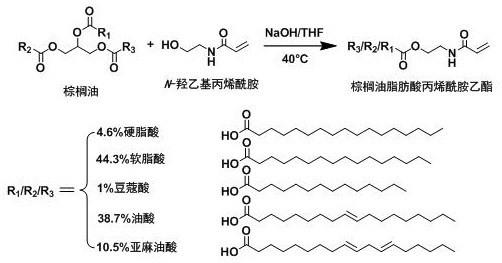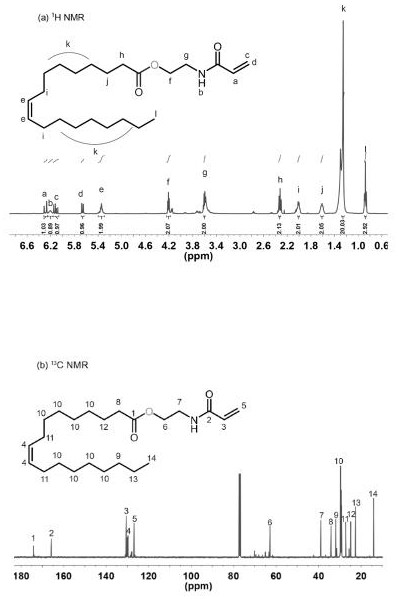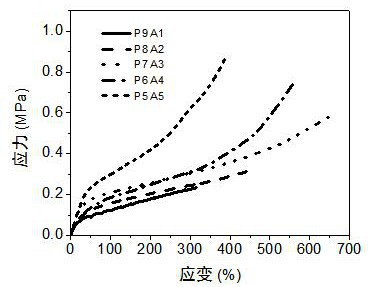Palm oil-based thermoplastic elastomer for digital light processing 3D printing
A thermoplastic elastomer and digital light processing technology, applied in the direction of additive processing, etc., can solve the problems of difficult solid-liquid separation in light-curing printing of thermoplastic materials, poor mechanical properties of vegetable oil elastomers, and complicated preparation processes, etc., to achieve low price, Excellent mechanical properties and large output
- Summary
- Abstract
- Description
- Claims
- Application Information
AI Technical Summary
Problems solved by technology
Method used
Image
Examples
Embodiment 1
[0026] Digital Light Processing 3D Printing Palm Oil-Based Thermoplastic Elastomers:
[0027] The synthesis process of palm oil fatty acid acrylamide ethyl ester: 150g palm oil and 150mL THF are placed in a three-necked flask; then add 115g N -Hydroxyethylacrylamide, 0.1g 2,6-dimethylphenol, 5g sodium hydroxide; then, place the flask in a water bath and stir it magnetically at 150 r / min at 40°C for 16 h; the reaction products are saturated After repeated purification of salt water for 3 to 5 times, it was purified by rotary evaporation to obtain palm oil fatty acid acrylamide ethyl ester.
[0028] Elastomer preparation method: Mix 18g of palm oil propylene-based monomer, 2g of acrylic acid and 0.4g of photoinitiator evenly and then pour it into a digital light processing 3D printer. Print at a speed of 20mm / h.
[0029] In the preparation process, the amount ratio of palm oil propylene-based monomer to acrylic acid is 9:1 by mass ratio; the amount of initiator is 2% of the ma...
Embodiment 2
[0031] Digital Light Processing 3D Printing Palm Oil-Based Thermoplastic Elastomers:
[0032] The synthesis process of palm oil fatty acid acrylamide ethyl ester: 150g palm oil and 150mL THF are placed in a three-necked flask; then add 115g N -Hydroxyethylacrylamide, 0.1g 2,6-dimethylphenol, 5g sodium hydroxide; then, place the flask in a water bath and stir it magnetically at 150 r / min at 40°C for 16 h; the reaction products are saturated After repeated purification of salt water for 3 to 5 times, it was purified by rotary evaporation to obtain palm oil fatty acid acrylamide ethyl ester.
[0033] Elastomer preparation method: Mix 16g of palm oil propylene-based monomer, 4g of acrylic acid and 0.4g of photoinitiator evenly and pour it into a digital light processing 3D printer. Print at a speed of 20mm / h.
[0034] In the preparation process, the amount ratio of palm oil propylene-based monomer to acrylic acid is 8:2 by mass ratio; the amount of initiator is 2% of the mass of...
Embodiment 3
[0036] Digital Light Processing 3D Printing Palm Oil-Based Thermoplastic Elastomers:
[0037] The synthesis process of palm oil fatty acid acrylamide ethyl ester: 150g palm oil and 150mL THF are placed in a three-necked flask; then add 115g N -Hydroxyethylacrylamide, 0.1g 2,6-dimethylphenol, 5g sodium hydroxide; then, place the flask in a water bath and stir it magnetically at 150 r / min at 40°C for 16 h; the reaction products are saturated After repeated purification of salt water for 3 to 5 times, it was purified by rotary evaporation to obtain palm oil fatty acid acrylamide ethyl ester.
[0038] Elastomer preparation method: Mix 14g of palm oil propylene-based monomer, 6g of acrylic acid and 0.4g of photoinitiator evenly and pour it into a digital light processing 3D printer. Print at a speed of 20mm / h.
[0039] In the preparation process, the amount ratio of palm oil propylene-based monomer to acrylic acid is 7:3 by mass ratio; the amount of initiator is 2% of the mass of t...
PUM
| Property | Measurement | Unit |
|---|---|---|
| melting point | aaaaa | aaaaa |
| acid value | aaaaa | aaaaa |
| thickness | aaaaa | aaaaa |
Abstract
Description
Claims
Application Information
 Login to View More
Login to View More - R&D
- Intellectual Property
- Life Sciences
- Materials
- Tech Scout
- Unparalleled Data Quality
- Higher Quality Content
- 60% Fewer Hallucinations
Browse by: Latest US Patents, China's latest patents, Technical Efficacy Thesaurus, Application Domain, Technology Topic, Popular Technical Reports.
© 2025 PatSnap. All rights reserved.Legal|Privacy policy|Modern Slavery Act Transparency Statement|Sitemap|About US| Contact US: help@patsnap.com



